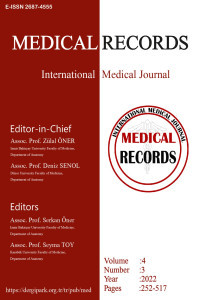Türk Hemşirelik Öğrencilerinin Gözünden Yaşam Sonu Bakım ve Ölüm: Bir Kalitatif Araştırma
Terminal Care and Death Through the Eyes of Turkish Nursing Students: A Qualitative Research Study
nursing, student, terminal care, death,
___
- 1. Kübler-Ross E. On death and dying (Büyükal B, Translation Editor). Istanbul: Boyner Holding Publications; (Original study publication date 1969).1997.
- 2. Öz F. Basic concepts in healthcare. Publisher: Image Domestic and Foreign Trade (İmaj İç ve Dış Ticaret) Ankara. 2004.
- 3. Eues SK. End-of-life care: improving quality of life at the end of life. Prof Case Manag. 2007;12(6):339-44. doi:10.1097/01.PCAMA.0000300408.00325.1c
- 4. Sahin M, Demirkiran F, Adana, F. Nursing Students’ Death Anxiety, Influencing Factors and Request of Caring For Dying People. Journal of Psychiatric Nursing. 2016; 7(3):135–141. doi: 10.5505/phd.2016.66588
- 5. Uysal N, Ceylan E, Koc A. Nursing Students' Attitudes on Care of Dying Individuals. Gumushane University Journal of Health Sciences. 2019; 8(1): 98- 105.
- 6. Birol, L. Patient Care In Terminal Period. Editor: Nuran Akdemir, Leman Birol. Internal Diseases and Nursing Care. 1st edition. Publisher: Vehbi Koc Foundation SANERC. Publication No. 2, Istanbul, 210. 2003.
- 7. Bilge A, Cam, O. Therapeutic approach of the psychiatric nurse to the terminally ill patient and his/her relatives. Journal of Ege University Faculty of Nursing. 2004; 20:127–36.
- 8. Inci F, Oz F. Palliative care and death anxiety. Current approaches in Psychiatry. 2012; 4:178–87.
- 9. Özer Z, Yıldırım D, Bölüktaş P. Attitudes of Nursing Students Towards Death. Journal of Economics and Social Research. 2015; 2(4): 1-13. doi: 10.10.2014/05.01.2015
- 10. Xu F, Huang K, Wang Y, Xu Y, Ma L, Cao Y. A Questionnaire Study on the Attitude towards Death of the Nursing Interns in Eight Teaching Hospitals in Jiangsu, China. BioMed Research International. 2019; 1-8. https://doi.org/10.1155/2019/3107692
- 11. Üstükuş A. Investigation of the effects of nurses' death anxiety on their approach to deadly patient. Cukuova university Health Science Institute Master Thesis. 2019.Adana-Turkey.
- 12. Youssef HA. Nursing students' perception of dying and their contextualizing end of life and palliative care in nursing curriculum at Taif University. European Journal of Academic Essays. 2016; 3(5): 193-199.
- 13. Cokluk O, Yilmaz K, Oguz EA Qualitative Interview Method: Focus Group Interview. The Journal of Theoretical Educational Science. 2011; 4(1):95-107.
- 14. Kartal H, BalantekinY, Bilgin A, Soyucok M. Factors Affecting Bullying in Home and School Life: A Mixed Method Research. Journal of Qualitative Research in Education. 2019;7 (1): 50-85. doi:10.14689/issn.2148-2624.1.7c1s.3m.
- 15. Isik E, Fadiloglu O, Demir YA Study of the Reliability and Validity of the Turkish Version of Death Attitude Profile in the Nurse Population.Turkish Journal of Research & Development in Nursing. 2009: 11(2): 28-43.
- 16. Koku F, Ates M. Nurses' Experiences and Attitudes Towards Death in Improving the Quality of Terminall Ill Patient Care. Journal of Health and Nursing Management. 2016: 2, 3: 99-104. 17. Yilmaz E, Vermisli S. Attitudes of intensive care unit nurses toward death and provision of care to terminally ill patients. Celal Bayar University Journal of the Institute of Health Sciences. 2015: 2, 2, 41-46.
- 18. Erdogan S, Nahcivan N, Esin N. Research in Nursing (First Edition). Nobel Tıp Kitabevleri Tic.Ltd.Şti.,150-155, İstanbul. 2014.
- 19. Koc Z, Saglam Z. Determining the Emotions and Opinions of Nursing Students Related to End-Of-Life Care and Death State. Journal of Cumhuriyet University The School of Nursing. 2008 12: 13-21.
- 20. Kurz M, Hayes E. End of life issues action: Impact of education. Int J Nurs Educ Scholarsh. 2006; 3:18.
- 21. Tarhan F, Arı F. The Meanıng Unıversıty Students Gıve To Death And Death Anxıety Levels Accordıng To Theır Department. Yüzüncü Yıl University, Faculty of Education Journal. 2006; 2: 44-55.
- 22. Bilge A, Embel N, Kaya FG. Attitudes of health professional students to death and the relationship between death anxiety and the variables affecting them. J Psy Nurs. 2013; 4: 119-124.
- 23. Kumar S, Chris E, Pais M, et al. Nursing students' perceived attitudes towards death: a cross-sectional survey. Indian Journal of Forensic Medicine & Pathology. 2013; 7 (1): 5-15.
- 24. Inci F, Oz F. Effects of death education on nurses' death anxiety, depression regarding death, and attitudes towards the dying patient. Anatolian Journal of Psychiatry. 2009;10: 253-260.
- 25. Taşdemir G, Gök F. Bir sağlık yüksekokulu’nda okuyan öğrencilerin ölüm kaygılarının belirlenmesi. International Journal of Human Sciences [Online]. 2012; (9): 303-317.
- 26. Ay F, Gencturk N. Midwifery Student’s Opinions Related to Death, Terminal Period and Palliative Care: Focus Group Study. Florence Nightingale Journal of Nursing. 2013; 21 (3): 164-171.
- 27. Cavdar I. Care of the cancer patient in the terminal period. Turkish Journal of Oncology. 2011;26 (3): 142-147.
- 28. Gurkan A, Gumus AB, Dodak H. The Opinions of Nursing Students about Issues of Terminal Stage Patients: The Investigation in the Context of Nursing Interventions, Patient Rights and Ethical Issue. M. Ü. Journal of Nursing Science and Art. 2011; 4 (1): 2-12.
- Yayın Aralığı: Yılda 3 Sayı
- Başlangıç: 2019
- Yayıncı: Zülal ÖNER
Hilal YILDIRIM, Sedat YILDIZ, Tuba ÖZGÖÇER
Karotis Arter Intima-Media Kalınlığının Tahmininde Monosit-HDL Oranı
İnfratemporal Locaya Deplase Olmuş Maksiller Üçüncü Molar Dişin İntraoral Yaklaşım İle Çıkartılması
Metin Berk KASAPOĞLU, Gözde GÖKÇE, Ahmet Taylan ÇEBİ, Burak ÇANKAYA
MAO-B İnhibitörü Kullanan Progresif Supranükleer Palsi’li Hastada Spinal Anestezi Deneyimi
Erol TOY, Kenan KART, Duygu TAŞKIN
COVID-19 Pandemisi Sürecinde Sağlık Profesyonellerinin Mesleki Yorgunluklarının Değerlendirilmesi
Özlem ÇAĞAN, Zeynep IRMAK KAYA
Akciğer İnvazyonu Ve İnguinal Bölgede Dev Kitle İle Prezente Olan Akral Melanom
Nurhayat OZKAN SEVENCAN, Ahmet Mert YANIK, Özlem BAYKAL, Yusif JAFAROV, İlhan Asude AKÇA, Duygu GÜL, Erol BAT, Onur TANGUR, Adem AKBAL, Ayse Rana SARIKAYA, Burçak KAYHAN
Mahmut ŞAHİN, Cemile Ayşe GÖRMELİ, Nurullah DAĞ, Fuat KURT
Ciddi Epistaksis olan Hastalarda Rutin Koagülasyon Teslerinin Değerlendirmesi
Bora ÇEKMEN, Öner BOZAN, Şeref Emre ATİŞ, Sevilay Sema ÜNVER, Kamil KOKULU, Asım KALKAN
Streptozotosin Diyabeti Oluşturulan Ratlarda Protein Oksidasyonunun Değerlendirilmesi
